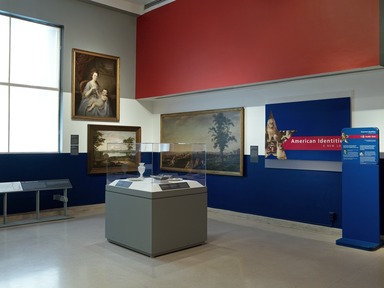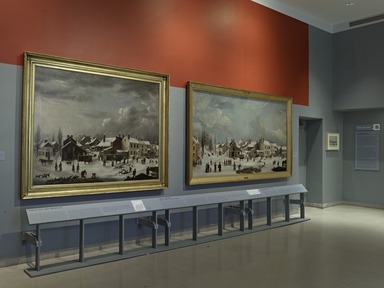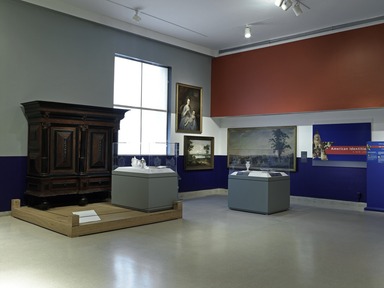

Picturing Place: Francis Guy's Brooklyn, 1820, March 20, 2006 through June 18, 2006 (Image: DIG_E_2006_Guy_01_PS2.jpg Brooklyn Museum photograph, 2006)

Picturing Place: Francis Guy's Brooklyn, 1820, March 20, 2006 through June 18, 2006 (Image: DIG_E_2006_Guy_02_PS2.jpg Brooklyn Museum photograph, 2006)

Picturing Place: Francis Guy's Brooklyn, 1820, March 20, 2006 through June 18, 2006 (Image: DIG_E_2006_Guy_03_PS2.jpg Brooklyn Museum photograph, 2006)
Picturing Place: Francis Guy's Brooklyn, 1820
DATES March 20, 2006 through June 18, 2006
ORGANIZING DEPARTMENT
American Art
COLLECTIONS
American Art
RELATED LINKS
Main Exhibition Page
-
Picturing Place: Francis Guy’s Brooklyn, 1820
This exhibition brings together, for the first time in more than 180 years, two scenes of downtown Brooklyn made about 1820 by the early landscape painter Francis Guy (1760–1820). These monumental, complex paintings represent the familiar buildings, residents, and activities of what was then a burgeoning village on a winter day. By the mid-nineteenth century, the pictures had come to be considered important historical documents and, as such, shaped future generations’ perceptions of what Brooklyn was like at the time.
This exhibition explores the ways in which art constructs the identity of a place. Physical or topographical appearance is one of the defining aspects of a particular locale. In his two Winter Scenes, Guy captured in great detail Brooklyn’s bustling streets and distinctive architecture. While this reportorial approach suggests a focus on the local, the paintings also resonate with nationalistic significance. Guy’s pictures are featured with other landscape imagery from the period to trace the developing interest in American scenery as a source of aesthetic beauty and national pride.
The identity of a place is shaped not only by its physical characteristics but also by its human element. Guy represented the Brooklyn community as comprising a range of professional, social, and ethnic groups. Other objects associated with the area further testify to a Brooklyn which then, as now, was marked by diversity.
Picturing Place: Francis Guy’s Brooklyn, 1820 was made possible by the American Art Council of the Brooklyn Museum. It was organized by Karen Sherry, Assistant Curator of American Art. -
Francis Guy and Brooklyn
Trained as a tailor and silk dyer, Francis Guy immigrated to America from England in 1795. He spent most of the next twenty years in Baltimore and in 1800 added landscape painting to his repertoire of skills. Between settling in Brooklyn in 1817 or 1818 and his death in 1820, Guy painted at least five views of his neighborhood from the second-story window of his home on Front Street. Three small pictures depict the architectural setting only; the two largest and most complex versions (one owned by the Brooklyn Museum and the other by a private collector) are on view here. Originally, these two canvases were nearly identical except for variations in the sky and some of the figural vignettes. An artist with an entrepreneurial spirit, Guy probably created multiple scenes in order to capitalize on emerging civic pride—the area of Brooklyn portrayed had been incorporated as a village in 1816. His plan to exhibit the works in New York and Baltimore suggests that he also anticipated national interest in the subject matter. -
The Paintings' Reception and History
From the time the Museum’s Winter Scene in Brooklyn was first exhibited in 1820, art critics marveled at its beautiful atmospheric effects and the striking likenesses of both architecture and people. A New York Evening Post reporter declared it “a master piece evincing no ordinary genius” (1821). In 1846, it became one of the first paintings to enter the collection of the fledging Brooklyn Institute (the Museum’s forerunner). Both of Guy’s Brooklyn scenes were widely disseminated during the nineteenth century through reproductions, including the prints on view here that document the paintings’ original compositions before subsequent modifications. Notably, the Museum’s painting lost almost two feet from its left side in an 1881 fire. The version from a private collection once had a painted balustrade along its lower edge (trimmed for unknown reasons), a feature that evoked the artist’s window ledge. As a sign of the enduring historical and aesthetic value of Guy’s image, Winter Scene in Brooklyn remains one of the icons of the Museum’s American art collection. -
Brooklyn Identities
One feature that distinguishes Francis Guy’s Brooklyn scenes from other townscapes of the period is the strong human dimension. His figures are not merely staffage, or anonymous figures subordinated to the setting as in traditional landscapes, but portraits of actual residents. The artist reportedly called out to neighbors from his window, asking them to freeze in position while he captured their likenesses. He created an image of Brooklyn as having a diverse community, with people of varying ages, occupations, social status, national backgrounds, and races. Notably, several African Americans occupy prominent positions in the foreground. Guy also alludes to the Dutch heritage of some Brooklynites through the architectural elements: the overhanging eaves of Abiel Titus’s house and barn resemble the homesteads of early settlers.
Dutch farmers were the first Europeans to settle on Long Island under the auspices of the Dutch West India Company, which chartered six towns in what is now Kings County (including Brooklyn, in 1646; see map). Long after the English took over in 1664, the county largely retained its Dutch and rural character, with the exception of Brooklyn. Strategically located across the river from Manhattan, Brooklyn developed into an urban center with a large and varied population and thriving commercial and manufacturing activities. Objects on view here explore the different identities of the people who made Brooklyn their home. -
The American Scene
When Francis Guy completed his Brooklyn scenes about 1820, landscape painting was a relatively new phenomenon in American art. During the colonial period, landscapes were uncommon and often depicted idealized subjects drawn from European artistic models rather than from nature. As the United States developed, growing prosperity, nationalism, and tourism sparked interest in the American scene. By the late eighteenth century, several artists, including Francis Guy, began seeking inspiration from America’s distinctive scenery. Their pictures of towns, landmark buildings, and natural wonders celebrated the young nation’s progress, beauty, and material abundance. Generally, these landscapists strove for topographical accuracy, although they were still informed by aesthetic concerns. By midcentury, with the rise of the Hudson River School (examples of which are on view in neighboring galleries), landscape painting had flowered into a significant facet of American art.
Landscape imagery also appeared in prints and books, as well as on decorative-arts objects, to meet the popular demand for such subjects. Several objects on view here used the modern technological process of transfer-printing, by which manufacturers could apply a single engraved image onto multiple items. English potteries produced large quantities of affordable ceramics with picturesque views of the United States specifically for the American market.
-
The Paintings: Who, What, and Where
Francis Guy’s Winter Scenes provide a panoramic yet highly detailed picture of the section of Front Street between Main and Fulton streets, an area now under the Brooklyn Bridge (see map). In 1820 this was the most urbanized part of Brooklyn because of its proximity to the Fulton Ferry dock, the primary port to Manhattan for both people and goods from across Long Island. Although Guy exaggerated the curve of Front Street (along the foreground), he carefully rendered the snow-capped buildings of the village, including elegant town houses (see key, nos. 14 and 15); various businesses such as a hardware store and carpenter’s shop (nos. 1 and 10); and, dominating the center of the composition, Abiel Titus’s “Dutch-style” barn (no. 9). After painting the architectural setting, Guy populated his scenes with Brooklynites going about their daily activities. Some of the identifiable individuals are Augustus Graham (no. 20), a businessman and philanthropist who played a formative role in establishing this Museum; the carpenter Benjamin Meeker, who holds the tools of his trade (no. 27), talking with Judge John Garrison (no. 28); and Samuel Foster, an African American chimney sweep (no. 35). The artist also alludes to the community’s vitality by placing piles of wood and coal—the raw materials that fuel the village—prominently in the foreground.
-
December 8, 2005
For the first time in more than 180 years, Francis Guy’s Winter Scene in Brooklyn, one of the earliest paintings to enter the Brooklyn Museum collection, will be exhibited alongside another version of the subject on loan from a private collection. The paintings, considered important historical documents of how the village of Brooklyn appeared in 1820, will be displayed together with some twelve related objects from the Museum’s collection, including paintings, works on paper, furniture, ceramics, silver, and a journal written by a young woman who resided in the area during this period. Picturing Place: Francis Guy’s Brooklyn, 1820 is a focused exhibition that examines ways in which art constructs community identity. It will be on view from March 20 through June 18, 2006, at the entrance to the Luce Center for American Art.
Francis Guy painted multiple versions of this Brooklyn scene shortly before his death in August 1820. In addition to the two paintings in the exhibition, there are three smaller, figureless versions (including one in summer). In 1846 Winter Scene in Brooklyn entered the collection of the Brooklyn Institute (predecessor to the Brooklyn Museum), then located on Washington Street, where in 1881 the painting was damaged in a fire. A section of about twenty-four inches on the left side of the Museum’s canvas was lost, but this area is intact in the private collection painting and nineteenth-century prints.
Painted from the second-story window of his house on Front Street, Guy’s two large winter scenes provide a glimpse into the burgeoning village—its bustling activity, architecture, and colorful residents. In addition to capturing Brooklyn’s distinctive look, the artist tapped into the growing demand for American subjects. The exhibition situates Guy’s works within the evolution of American landscape painting from picturesque scenes indebted to European artistic conventions, to topographical studies celebrating the young nation’s development.
In Guy’s Brooklyn paintings, people play an equally important role as the urban setting; hence, another section of the exhibition explores the identities of Brooklynites of the period who were then, as now, diverse. Guy represents this diversity in several ways: portraying a range of classes (from manual laborers to merchants), including several African Americans (some of whom were slaves), and alluding to the town’s Dutch ancestry (with an old-fashioned barnyard).
Picturing Place: Francis Guy’s Brooklyn, 1820 has been organized by Karen A. Sherry, Assistant Curator of American Art at the Brooklyn Museum.
View Original















